On patrol with the Indigenous Guards of Colombia
Armed with walkie talkies, wooden staves, the Guard has led a nonviolent effort to protect their land for decades.

Tacueyo, Cauca – Jose Norman Montano carried his infant daughter close to his chest as he slashed through untamed banana leaves, carving a passage to reach the crest of a hill.
“Zero-zero-20, do you copy?” A voice crackled a reply from his walkie talkie reporting the findings on a different mountain. In the distance, a thin plume of smoke dissipated into the midday heat – maybe a sign of one of the armed groups camped out on Indigenous land.
Keep reading
list of 4 itemsIndigenous people in Philippines’s north ‘ready to fight’ as tensions rise
Curfew announced for under-18s in Australia’s Alice Springs after unrest
‘We exist’: A Himayalan hamlet, forgotten by Indian democracy
Montano peered through a spyscope before passing it off to a woman, who held it to her five-year-old daughter’s squinting eyes. All 12 in the group wore blue cotton vests embroidered with the words, “Kiwe Thegnas”, on the back – “land defenders” in their people’s native language, Nasayuwe. For kilometres in every direction, hundreds of people in the same uniform combed the Nasa Indigenous reserve of Tacueyo in the wartorn state of Cauca, looking for possible threats. Every now and then, the static gurgling from their radios coalesced into words: “Kiwes, we might have a situation down below.”
The dawn to nightfall operation was part of Norman’s duty as part of the Guardia Indigena – Indigenous Guard – an unarmed civilian defence force of women, men, children, and elders that has stood up to violence in their territories for decades. Using sheer power in numbers, they work to prevent armed groups from seizing control in an area that has been plagued with conflict for generations.
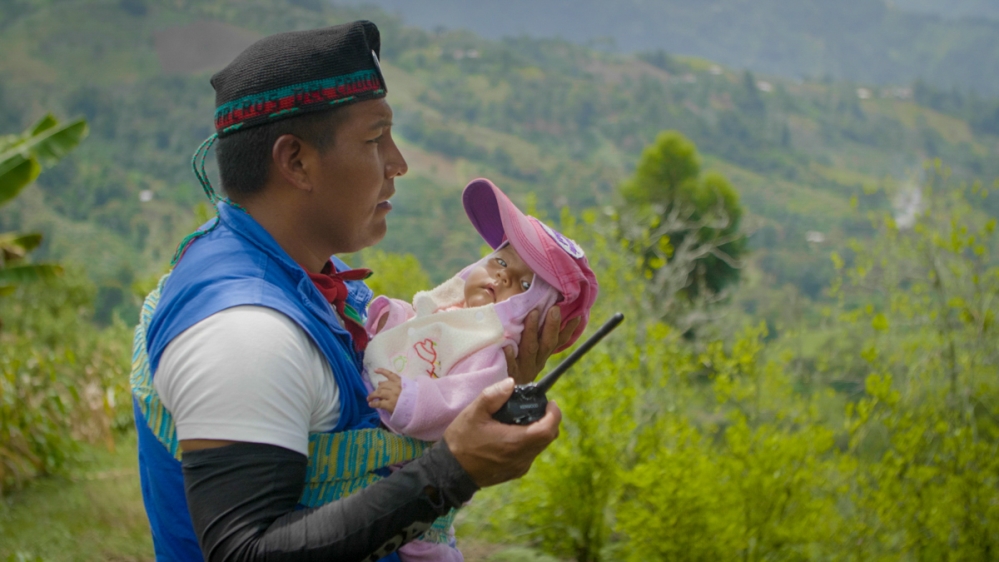
In recent weeks, the Guards have joined hundreds of thousands of others across Colombia who have rallied in a national strike against the government of President Ivan Duque.
Colombians, frustrated by issues ranging from pension cuts to assassinations of social leaders, have taken to the streets since November 21. For the Indigenous Guards in Cauca, the historic mobilisation represents just another step on a long and interminable path of resistance. The practice of mass dissent is a familiar one to them, older than any administration – the only difference this time is the scale of solidarity.
“This is what we’ve always sought,” Luis Ascue, a former leader of the Guard told Al Jazeera, speaking of the recent protests. “We are always stronger together,” he said.
Defenders of life
Saddled over the shoulder of every Guard, where a rifle might go, are wooden staves adorned with red and green ribbons – the colours of blood and earth. To an unknowing spectator, the blunt sticks might seem impotent against the threat of gunfire, but their staves are ancestral symbols of authority endowing strength deeper than the crude force of weaponry.
Cauca has always been a hotbed of the country’s half-century-long armed conflict. Rebel groups installed themselves in the state’s sprawling green mountains; army and paramilitary forces sought to exterminate them. Indigenous communities in the area have lived at the crossfire for generations.

In 1971, the Regional Indigenous Council of Cauca (CRIC) was established, consolidating a groundswell effort by Indigenous people across multiple tribal identities working to reclaim their ancestral land. As a result of their grassroots organising in Cauca, Indigenous peoples throughout Colombia now have constitutionally protected collective territories and autonomy rights. These advances were made possible because of the movement’s dogged efforts carrying out dozens of highway blockades, mass marches, and other forms of peaceful civil disobedience to reverse state oppression.
But as the CRIC gained regional strength, it became a target of armed groups on every side of the conflict threatened by its grassroots power. The Guard emerged as an instrument of territorial defence with the principle that they could not control the war through more violence.
“The strategy is called Active Neutrality,” said Ezequiel Vitonaz, an Indigenous former mayor of Toribio, a town near the birthplace of the Guardia.
“We weren’t just going to sit back and let ourselves be annihilated,” Vitonaz told Al Jazeera. “But by using weapons, we would just be another armed group like all the other ones keeping this conflict alive, and it hasn’t worked for more than 50 years.”
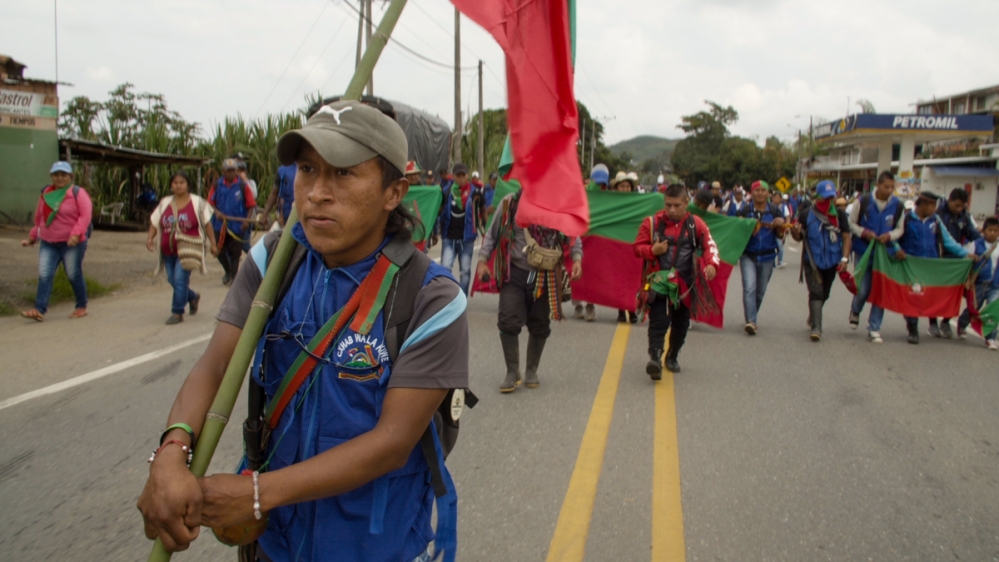
The Guard activated as an organised force in 2001 after the brutal paramilitary massacre of Naya that left dozens of civilians dead or injured, and forecast the risk of expanding paramilitary power. Rather than add to the bloodshed, the Guards dialogue with different parties of the conflict to negotiate solutions – a tactic that earned them Colombia’s National Peace Prize in 2004. They have maintained a sophisticated intelligence network of checkpoints where they monitor who goes in and out of Indigenous territories.
The Guard’s peaceful methodology has been so successful at resisting the armed conflict that it has proliferated throughout Colombia. There are now 60,000 active members across the country – 13,000 of whom are in Cauca. The service is voluntary and without remuneration, but participation continues to grow. Leaders of the Nasa Guard in Cauca have trained Afro-Colombian and peasant communities to develop their own versions – the guardia cimarrona, and guardia campesino.
The Guard’s power comes from implacable unity and spiritual practices connecting them to the land they protect. The force is not so much defending against armed groups in the conflict, as a deeper concept of harmony at the root of the Nasa cosmovision, which the violence disrupts.
When confrontations occur, the Guard activates the masses with a quick of alert that disseminates over the radio.
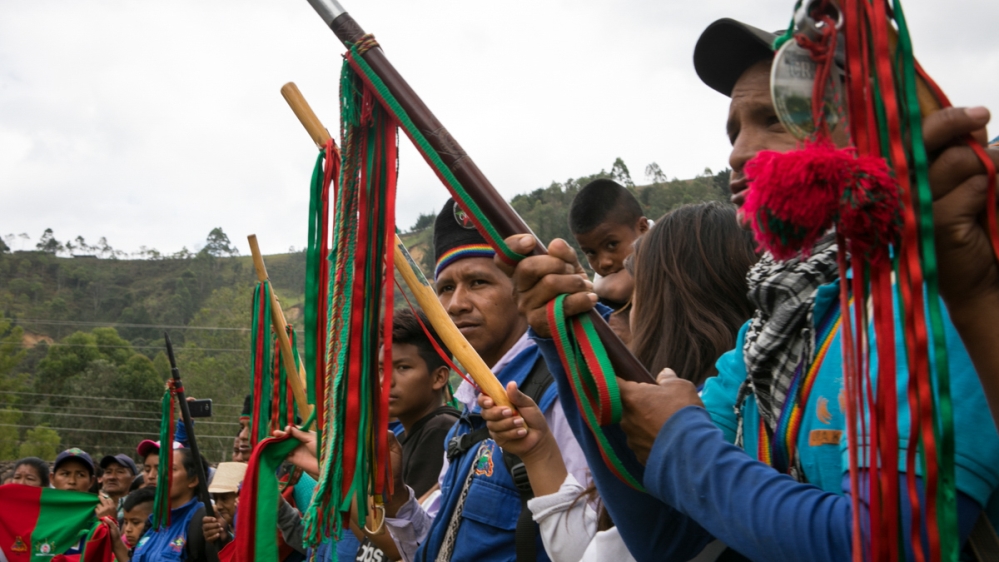
That was their approach in February of 2018, when a group of armed dissidents descended upon the town of Tacueyo to retrieve the weapons that the Guard had confiscated from them. At the first sign of danger, the patrolling guardia called for backup, and within minutes, hundreds of people surrounded the assailants.
The tactic has worked more times than Ascue can remember. Even heavily armed personnel, when they find themselves engulfed by an entire community, are reluctant to murder thousands of men, women, elders, and children, that quickly swarm in around them.
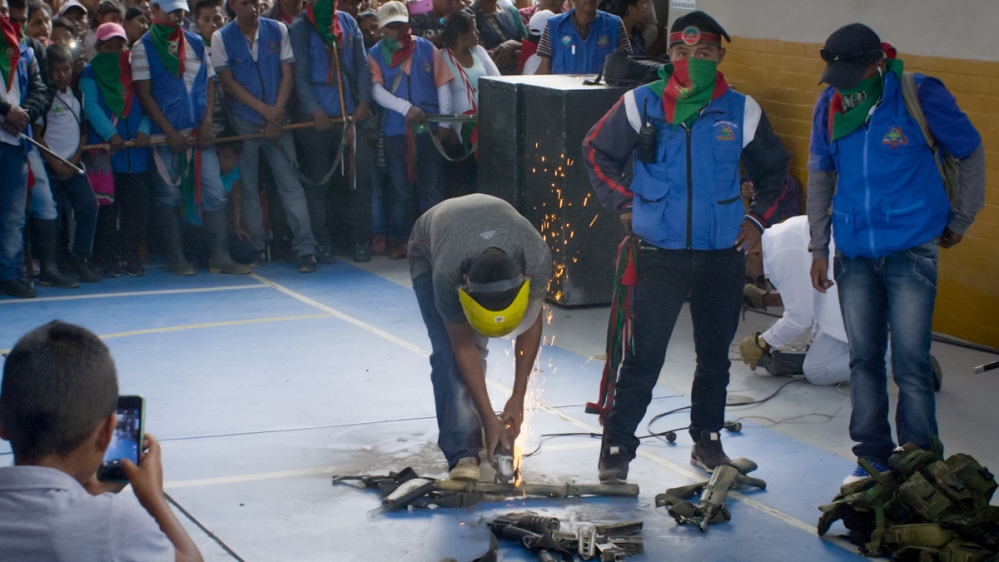
A few days after the skirmish in 2018, the Guard held a public assembly, where they sawed through every machinegun and broke apart each bullet in a ceremonial act to reject the violence.
“From the very beginning, we designed La Guardia from the strength of the collective,” Ascue said. “It’s not just those of us who actively patrol; the Guard is all of us. We are defending life.”
A new breed of violence
The Guard’s efficacy confiscating weapons and capturing assailants has made them the targets of retaliatory violence, which is on the rise.
In the wake of Colombia’s 2016 peace accord between the Revolutionary Armed Forces of Colombia (FARC) rebel group and the government, the armed networks in Cauca reconfigured. Dissident factions broke off from the peace process and splintered into new groups vying for territorial control. Whereas the FARC was a unified rebel organisation with a clear chain of command, their descendants are smaller criminal networks without revolutionary goals. Instead, they seek profit above all else, which they secure by extortion, narcotrafficking, or financial rewards for killing off the main group preventing them from seizing power: the Indigenous Guard.
“The situation is more complicated than it’s ever been,” a coordinator of the Guard told Al Jazeera.
“We were never the principal targets before. Now, there’s no way of knowing who to dialogue with, so it’s very hard to negotiate the way we used to,” added the coordinator, who wished not to be named.
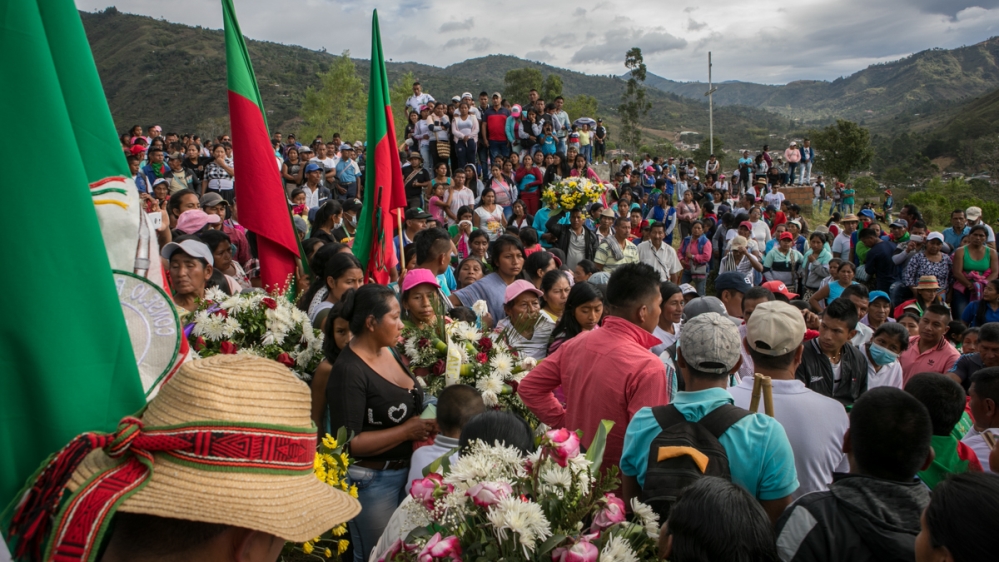
Since 2016, more than 750 social leaders have been killed. Indigenous leaders in this part of the country are among the most victimised. In Cauca alone, there have been at least 127 homicides, 264 individual threats, 80 collective threats, 32 assassination attempts and seven massacres, according to CRIC records.
“Just in 2019, they’ve assassinated more than 67 people,” one of the heads of the organisation, Ermes Pete Vivas, said during a speech in Caldono on the first day of the national strike. Many people at the protest in Caldono wore cardboard cutout masks with the face of Christina Bautista, a beloved Indigenous governor who was killed in a high-profile massacre in Tacueyo on October 29. During that same week, 12 Nasa leaders in northern Cauca, mostly members of the Guard, were also slain.
In response to the massacre in Tacueyo, Duque ordered 2,500 soldiers to Cauca – a move that was a violation of Indigenous authorities’ wish to expel all armed groups from their territories, including the military. Many protesters attribute the recent uptick in violence to Duque’s failures carrying out the 2016 accord.
Speaking to local media, the national head of the Guardia, Lucho Acosta asked: “How many more of us have to be killed before the government complies?”
Newfound solidarity in the national strike
More than a 1,000 Guards travelled to Colombia’s capital Bogota earlier this month to participate in the national strike.
They became the focus of rally cries echoing in the city’s largest streets.
“Guardia guardia, fuerza fuerza!” – “Guardians guardians, strength strength!” they shouted. “Until when? Until forever!”
People rushed up to shake the Guards’ hands and thank them. The show of popular solidarity appeared to fulfil a call for unified resistance that the CRIC has exhorted throughout its existence.

Aida Quilcue, a prominent Nasa leader, spoke before the crowds assembled in Bogota on the day the Guard arrived in the city. “Before, we called upon you. Now, you have summoned us here, and this makes us feel proud,” she said, her voice quivering with emotion.
In March, Quilcue was part of a mobilisation the CRIC orchestrated to block the highway near Caldono, Cauca on the same stretch they walked on the first day of the national strike. Activists shut down the passage for nearly a month in a protest action known as “the minga”- a Quechua word for collective community effort.
During the March mobilisation, thousands of Guardia caravanned to Caldono from Indigenous reserves throughout Cauca on busses stacked high with supplies. Around the perimeter of the expansive encampments beside the Pan-American, lines of them patrolled the flow of people moving in and out, while other shifts descended onto the highway, braced for the barrage of tear gas and rubber bullets.
This is a struggle of millennia. We've been doing it for more than 500 years.
The mass protest was a sophisticated choreography of participation – from the women preparing huge pots of food, to spiritual elders defining strategies to withstand police repression – an expression of the Guard’s bottom-up power. They promised to sustain the blockades until Duque dialogued with them.
After 27 days of militarised police force failed to disband the protesters, the president agreed, but on the day of the proposed meeting, he stood up thousands of Indigenous demonstrators awaiting his arrival.
Several CRIC leaders reminded demonstrators at the strike last month that, “The Minga Continues.”
“We are walking our word, just as we have always done,” Quilcue told Al Jazeera. In 2008, the leader’s husband was killed by military officials in an attack that is widely believed was intended to assassinate her. Rather than accept state-sponsored bodyguards, she opted for the protection of her trusted Guardia Indigena.
Back in Tacueyo, the number of patrolling Guards has dwindled over recent months; four members were murdered, three more, including Jose Norman Montano, are recovering from grave injuries, and several others have been forced to flee the area. But their dedication hasn’t wavered.
“This is a struggle of millennia,” Quilcue said. “We’ve been doing it for more than 500 years.”